Baltimore Police Handcuffs Restraints
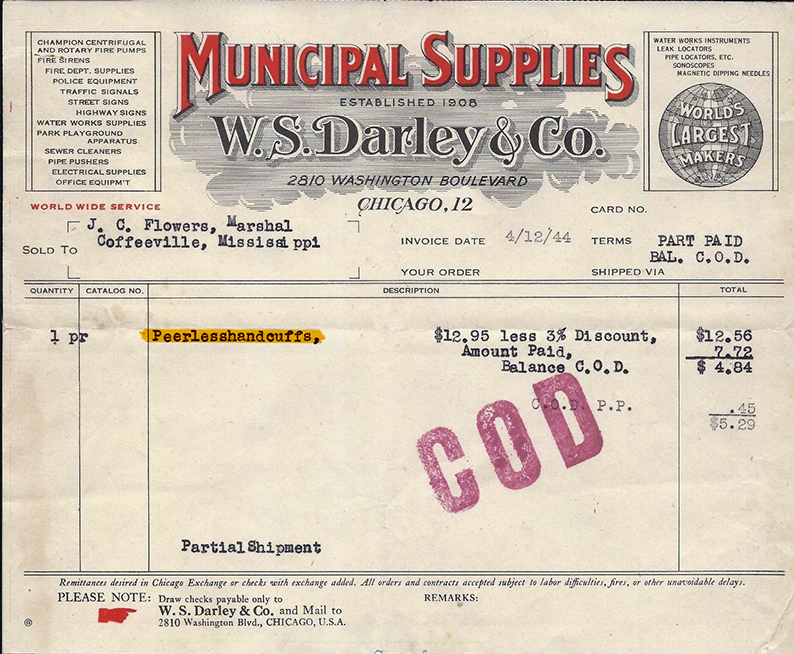
W.S. Darley Receipt courtesy Ray Wheatley
1944 Receipt for a set of Peerless Handcuffs
Catching criminals is only half the battle, restraining them can be several more battles throughout the course of effectively prosecuting them. Police have the odd job of fighting a man but only to a point which is necessary, the man he fights is trying to kill him, but the officer is only allowed to fight to a point which necessary to effect the arrest, after which he must, switch roles, offer first aid for injuries, then restrain and protect. Often a suspect is wanted by the public, so officers have to get the suspect safely before the courts. Many don’t realize jails and prisons are made as much to protect the prisoner from society and them to protect society from that prisoner. It used to be that jails were for punishment, a sort of adult timeout… then they became all about educating a man, teaching him the wrongs of his former self. They hope he will come out a better man. To get to that place and along the way we had restraints. This is a brief history of those restraints.

Baltimore Smith and Wesson Model 90 Handcuffs
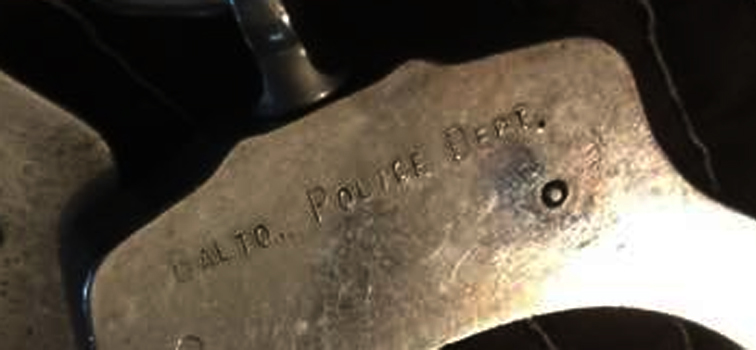
Here's a close-up of the marking
Why Do we Cuff all Prisoners Today
In Part Because of Cases Like this
On 19 Nov 1928 Captain John Carey night commander of police, received word that a man answering the description of a man wanted in New York for armed Robberies and the shooting of a New York City Police officer was in a Baltimore Street hotel. Three detectives were detailed to go to the location and bring the suspect in; Captain Carey told them to bring the suspect to police headquarters for questioning. The detectives tried up the location and found the person that was being reported but felt he was not the suspect wanted, by NYPD. Captain Carey said he told the three officers sent earlier of the dangers of this suspect, and let them know he was a dangerous and desperate character. While the Detectives didn’t think the guy they received a tip on was their suspect they still brought him in for questioning where they cleared him and released him shortly after.
Later the same morning Detective Sergeant Frederick W. Carroll received a phoned in a tip of a suspect at a downtown hotel, he didn’t have any info on the suspect, what he was wanted for, or even that three Detectives had already gone out on this call. All he had was that police were there earlier looking for a suspect, and that the suspect was there now. Detective Sergeant Carroll then left the station to investigate this complaint; he didn’t know it was guys out of his own unit/division that went. We don’t know who phoned in the tip, it may have been the person police brought in, and then released, or a hotel employee; we’ll never know. Likewise, we’ll never know why, Detective Sergeant Carroll didn’t look into it any further, or take back-up. He just took the name the caller gave him, grabbed a set of keys, and went alone… While at the hotel he located the suspect and arrested him. The two proceeded from the hotel to as far as Fayette Street, and Fallsway when the suspect pulled a pistol and demanded that Detective Sergeant Carroll put his hands up. Detective Sergeant Elmer O’Grady and Detective Joseph Carroll, who was looking out a window of the police building, ran out to assist Detective Sergeant Carroll, only to be met by the gunman’s fire. Detective Sergeant Carroll died a few minutes after being taken to the hospital. Oh, Grady and Joseph Carroll were reported as doing well.
Several things that should be known about the Baltimore Police 1928
1st - We didn’t cuff people in public
2nd - We didn’t search people in public, nor did we stand by and watch as other searched people in public. To that Commissioner Charles D. Gaither read the following from the rule book to the media:
“Members of the force shall not search, or act as a witness to the searching of any person in any place other than the station house, or headquarters unless such search is made for dangerous or deadly weapons suspected to be upon the person of the prisoner.”
In this case Det. Sgt. F Carroll had no info on the suspect and was within the rules of the Baltimore Police Department. It is because of cases like this, that we have the rules we have today, cases like this that let us handcuff people that are only suspected of a crime. And cases like this that let us search incident to arrest. This happened in 1928, things were so different, without radios on every shoulder, or hip like today, information wasn’t as freely distributed as it is today.
As his brothers and sisters of the Baltimore Police Department we will not let him be forgotten, His service Honored the City of Baltimore, and the Baltimore Police Department may he rest in peace, and may God bless him.
The suspect in this case also died of his injuries, but not before admitting to police that he was the suspect wanted in New York for robberies and Shootings, of two police officers in the NYPD
A Brief History of Handcuffs
since being used, in one form or another for centuries, they have had a variety of names. Manacles, Nippers, Thumb-cuffs, Grips, Hooks, Claws, Dowlers, Shackles, Handcuffs, often shortened to “Cuffs” are just a few of the names used. As for styles… we have the Iron claw originally put out by Argus, later sold under the name Pee Jay, then there is the Pistol Grip, A Policeman’s Hook, Harvey Chain Grip, a simple leather strap with a wooden turned handled used like a leash, to hogtie, the suspect twisting his/her arm behind their back and transport (normally walk them to a call box to wait for a wagon, or before that to walk them to the station. Over the years, there have been many styles of these mechanisms used primarily as restraints. What other uses than restraints, you wonder. Well, entertainment Houdini? His use of handcuffs was to escape from – not be restrained by - handcuffs, while he mesmerized crowds of spectators. And, in France in the 1950’s, the single locking La Pegy handcuff was thought to be a fashion statement. France fashion, Go figure! And let’s not forget those that used them as a sexual implement, (Ok let’s forget them… ) so much for fashion and style and such; let’s get down to the real deal/appeal about handcuffs.
From convicts to captives, to conjurers, to perverts, handcuffs have been used to detain, constrain, and entertain since they have been recorded in history.
The poet Publius Vergilius Maro, known in English as Virgil, recounts the legend of the
fitting of the first handcuffs on the mythical god Proteus. Possessing the gift of prophecy
but not the gift of giving, Proteus selfishly kept his knowledge to himself. Aristaeus knew
that the only thing that would compel Proteus to share his knowledge was to bind him
and not let go. This binding or cuffing is the first recorded (though mythical) use of what
we now call handcuffs.
But, there is more to the story of handcuffs. In the 4th century B.C., Carthaginians lugged
chariots full of handcuffs with them in their anticipation of conquering the Greeks.
During the 15th and 16th centuries, the words swivel manacle, and shackbold were used to
describe handcuffs. The word eventually evolved from the Anglo-Saxon “hand cop”,
meaning that which “cops” or “catches”, to the version of the word we use today –
handcuff.
Because the use of and need for restraining people developed before working metals were discovered, the first handcuffs were actually made from strips of animal hide, rope
made from reeds and vines was the updated method and material employed to confine
other human beings and prevent escape. As time progressed, so did human beings’ ability to make stronger, reusable hand cops/cuffs. This ability to make stronger handcuffs was introduced, along with the invention of locks, in the Bronze Age. During the Iron Age, a more sophisticated workmanship was forged. However, most handcuffs were ‘one size fits all’ and caused more pain for the bigger boned detainee and potential freedom for the small-wristed prisoner. They were simple metal rings that locked in place with no room for adjustment to the size of the captive’s wrists. That is until 1862 when there were major changes to handcuffs when inventor W.V. Adams patented a design for handcuffs that had adjustable ratchets. In 1865, John Tower, who
started one of the most successful American handcuff companies, used Adams’ design to
manufacturer handcuffs up until WWII. Now, there are literally hundreds of types of handcuffs. Some bought for collecting only, and some made to accommodate law enforcers in their need for swift and secure handling of disorderly crowds and individuals. For the swift securing of the unruly, Plasti-Cuffs are often used; they are flexible restraints that resemble the plastic ties used to secure cable lines in the field these are known as “Flex-cuffs”. With Universal Precautions the outlook of the day, Plasti-Cuffs help prevent the spread of disease, as they are disposable. They are also cheaper than the traditional metal restraints used by law enforcement, as well as easier to carry. (I should say they are said to be easier to carry, these used to be quite cumbersome, on raids guys would put a rack of these on their belt keeper and go in looking like a lineman.
So, the handcuff has evolved from myth to leather, to twine, to metal mechanism most popular throughout recent history back to a disposable one time use flexible, “Flex-cuffs”. All the while preserving the original uses – to constrain, detain and even entertain.
References –
Handcuffs.org
Yahoo.com
The rest is history.com -Article by J. Parker Adair
Handcuffs by Inspector Maurice Moser.
 Styles
Styles
Handcuffs which were worn during trials by the accused in the assassination of President Lincoln.
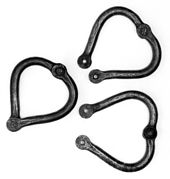
There are three main types of contemporary metal handcuffs: chain (cuffs are held together by a short chain), hinged (since hinged handcuffs permit less movement than a chain-cuff, they are generally considered to be more secure), and rigid solid bar handcuffs. While bulkier to carry, rigid handcuffs permit several variations in cuffing. Hiatts Speed-cuffs are rigid handcuffs used by most police forces in the United Kingdom. Both rigid and hinged cuffs can be used one-handed to apply pain-compliance/control techniques that are not workable with the chain type of cuff. Various accessories are available to improve the security or increase the rigidity of handcuffs, including boxes that fit over the chain or hinge and can themselves be locked with a padlock.
In 1933 the Royal Canadian Mounted Police used a type called "Mitten Handcuffs" to prevent criminals from being able to grab an object like the officer's gun. While used by some in law enforcement it was never popular.
Handcuffs may be manufactured from various metals, including carbon steel, stainless steel, and aluminum, or from synthetic polymers.
Sometimes two pairs of handcuffs are needed to restrain a person with an exceptionally large waistline because the hands cannot be brought close enough together; in this case, one cuff on one pair of handcuffs is handcuffed to one of the cuffs on the other pair, and then the remaining open handcuff on each pair is applied to the person's wrists. Oversized handcuffs are available from a number of manufacturers.
The National Museum of Australia has a number of handcuffs in its collection dating from the late 19th and early 20th centuries. These include 'T'-type 'Come Along', 'D'-type and 'Figure-8' handcuffs.
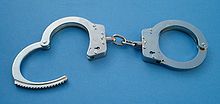

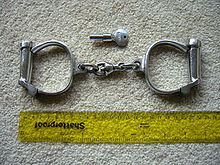
Double Locks
Handcuffs with double locks have a detente which when engaged stops the cuff from ratcheting tighter to prevent the wearer from tightening them. Tightening could be intentional or by struggling; if tightened, the handcuffs may cause nerve damage or loss of circulation. Also, some wearers could tighten the cuffs to attempt an escape by having the officer loosen the cuffs and attempting to escape while the cuffs are loose. Double locks also make picking the locks more difficult.
There exist three kinds of double locks as described in a Smith & Wesson brochure:
Lever lock: Movement of a lever on the cuff causes the detente to move into a position that locks the bolt. No tool is required to double lock this type of cuff.
Push pin lock: A small peg on the key is inserted end-wise into a hole to engage the detente.
Slot lock: These also are actuated with a peg, but in this case, it is inserted into a slot and moved sideways to engage the detente.
Double locks are generally disengaged by inserting the key and rotating it in the opposite direction from that used to unlock the cuff.
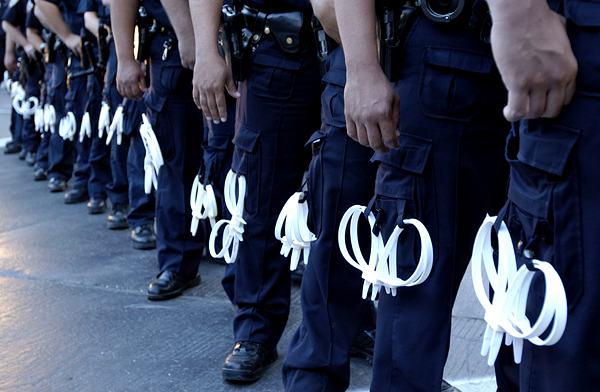
Plastic handcuffs
Plastic restraints, known as wrist ties, riot cuffs, plasti-cuffs, flex-cuffs, flex-cuffs, tri-fold cuffs, zap straps, zip-cuffs, or zip-strips, are lightweight, disposable plastic strips resembling electrical cable ties. They can be carried in large quantities by soldiers and police and are therefore well-suited for situations where many may be needed, such as during large-scale protests and riots. In recent years, airlines have begun to carry plastic handcuffs as a way to restrain disruptive passengers. Disposable restraints could be considered to be cost-inefficient; they cannot be loosened and must be cut off to permit a restrained subject to be fingerprinted, or to attend to bodily functions. It is not unheard of for a single subject to receiving five or more sets of disposable restraints in his or her first few hours in custody. However, aforementioned usage means that cheap handcuffs are available in situations where steel ones would normally lay unused for long times. Recent products have been introduced that serve to address this concern, including disposable plastic restraints that can be opened or loosened with a key; more expensive than conventional plastic restraints, they can only be used a very limited number of times, and are not as strong as conventional disposable restraints, let alone modern metal handcuffs. In addition, plastic restraints are believed by many to be more likely to inflict nerve or soft-tissue damage to the wearer than metal handcuffs.
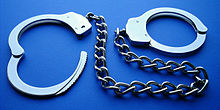
Leg-cuffs (leg-irons)
Standard type leg-cuffs (leg-irons) made in Taiwan
On occasions when a suspect exhibits extremely aggressive behavior, leg irons may be used as well; sometimes the chain connecting the leg irons to one another is looped around the chain of the handcuffs, and then the leg irons are applied, resulting in the person being "hog-tied". In a few rare cases, hog-tied persons lying on their stomachs have died from positional asphyxia, making the practice highly controversial, and leading to its being severely restricted, or even completely banned, in many localities.
Universal handcuff key
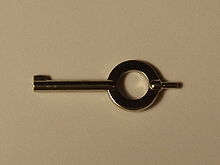
Keys
Most modern handcuffs in Canada, the United States, the United Kingdom and Latin America can be opened with the same standard universal handcuff key. This allows for easier transport of prisoners and keeps one out of trouble if one loses one's keys. However, there are handcuff makers who use keys based on different standards. Maximum security handcuffs require special keys. Handcuff keys usually do not work with thumb cuffs. The Cuff Lock handcuff key padlock uses this same standard key.
In addition to the Universal handcuff key, a few modified designs exist, including a key that has been molded to fit behind an officer's badge (colloquially known as "The New York Tuning Fork" (U.S Patent 607,305).
Hand Positioning
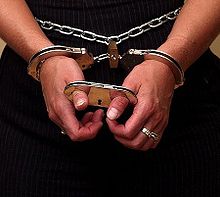
Old Handcuffs
In the past, police officers typically handcuffed an arrested person with his or her hands in front, but since approximately the mid-1960s behind-the-back handcuffing has been the standard. The vast majority of police academies in the United States today also teach their recruits to apply handcuffs so that the palms of the suspect's hands face outward after the handcuffs are applied. The Jacksonville, Florida Police Department, the Los Angeles County Sheriff's Department, and others are notable exceptions, as they favor palms-together handcuffing. This helps prevent radial neuropathy or handcuff neuropathy during extended periods of restraint. Suspects are handcuffed with the keyholes facing up (away from the hands) to make it difficult to open them even with a key or improvised lock-pick.
Hinged handcuffs applied behind the back, with palms facing outwards.
Because a person's hands are used in breaking falls, being handcuffed introduces a significant risk of injury if the prisoner trips or stumbles, in addition to injuries sustained from overly tight handcuffs causing Handcuff Neuropathy. Police officers having custody of the person need to be ready to catch a stumbling prisoner.
As soon as restraints go on, the officer has full liability. The risk of the prisoner losing balance is higher if the hands are handcuffed behind the back than if they are handcuffed in front; however, the risk of using fisted hands together as a weapon increases with hands in front.
Some prisoners being transported from custody to outside locations, for appearances at court, to medical facilities, etc., will wear handcuffs augmented with a belly chain. In this type of arrangement a metal, leather, or canvas belt is attached to the waist, sometimes with a locking mechanism. The handcuffs are secured to the belly chain and the prisoner's hands are kept at waist level. This allows a relative degree of comfort for the prisoner during prolonged internment in the securing device while providing a greater degree of restriction to movement than simply placing the handcuffs on the wrists in the front.
Miscellaneous
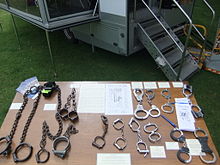
Display of old handcuffs, Tatton Park Flower Show, 2010
In Japan, if someone is photographed or filmed while handcuffed, their hands have to be pixelated if it is used on TV or in the newspapers. This is because Kazuyoshi Miura who had been arrested brought a successful case to court arguing that being pictured in handcuffs implied guilt, and had prejudiced the trial. Similarly, in Hong Kong, people being arrested and led away in handcuffs are usually given the chance by the policemen to have their heads covered by a black cloth bag.
Police handcuffs are sometimes used in sexual bondage and BDSM activities. This is potentially unsafe, because they were not designed for this purpose, and their use can result in nerve injury (Handcuff Neuropathy) or other tissue damage. Bondage cuffs were designed specifically for this application. They were designed using the same model of soft restraints used on psychiatric patients because they can be worn for long periods of time. Many such models can be fastened shut with padlocks.
Legcuffs
 Leg cuffs in use
Leg cuffs in use
Leg cuffs, shackles, footcuffs, fetters or leg irons are a kind of physical restraint used on the feet or ankles to allow walking but prevent running and kicking. They made the leg irons restrict running and kicking so that the prisoners could not fight back. The term "fetter" shares a root with the word "foot".
With respect to humans, typically only prisoners, bondage fetishists, and African American slaves while enslaved wore shackles. Leg shackles are used for chain gangs to keep them together.
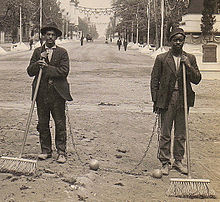
Chain Gang Street Sweepers, 1909
A shackled animal is typically either a dangerous animal or one prone to escape. Metaphorically, a fetter may be anything that restricts or restrains in any way, hence the word "unfettered".
History
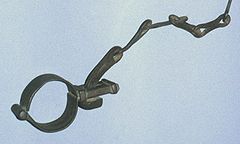
Cup lock shackle with no built-in lock
The earliest fetters found in archaeological excavations date from the prehistoric age and are mostly of the puzzle lock type. Fetters are also referenced in ancient times in the Bible.
In the Scriptures the Hebrew word necho′sheth, usually meaning “copper,” is frequently translated “fetters of copper” or “copper fetters,” because fetters were often made of copper or bronze, although wood and iron were also employed. (2Sa 3:34; 2Ki 25:7) In the British Museum, there is a pair of bronze fetters from Nineveh (the capital city of ancient Assyria) in the form of a bar with a ring at each end.
Roman times already see a variety of restraint types. Some early versions of cup lock shackles can already be found. These were widely used in medieval times but their use declined when mass production made the manufacture of locks built into restraints affordable.
Simple fetter types continue to be used like puzzle lock shackles as the typical slave iron or irons riveted shut for prisoners being transported to overseas prison camps.

Standard type leg irons made in Taiwan
The first built-in locks often were of a simple screw-type but soon developed into the "Darby" type. In Europe, these continued to be used into the middle of the 20th century, whereas in the US from the late 19th century onward many new designs were invented and produced before handcuffs and leg irons of the Peerless type became the standard several decades ago.
Controversial use
Heavy leg irons from China, including a metal plate to protect the keyhole from collecting dust or being tampered with
In comparison to handcuffs, the wearing of leg irons may be found less restrictive. Thus the prison authorities in several countries deem their long-term use acceptable. In order to avoid condoning this disputed practice the countries of the European Union have banned exporting leg irons into non-EU countries. The countries that continue to make prisoners wear fetters long term now tend to resort to manufacturing their own restraints.
Plastic handcuffs
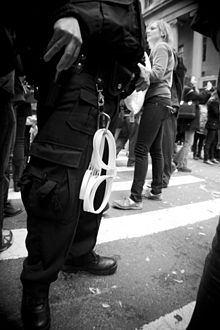
Policeman Carrying Plastic Handcuffs
Plastic handcuffs (also called PlastiCuffs or Flexi Cuffs or Double Cuffs) are a form of physical restraint for the hands, using plastic straps. They function as handcuffs but are cheaper and easier to carry than metal handcuffs; they cannot be reused.
The traditional form of plastic handcuffs are cable ties, either two interlocking straps, or a single cable tie around both wrists. More recently, plastics-manufacturing companies have started to produce special devices comprising two interconnected straps as one item. These are generally injection molded nylon items, selling for tens of cents each. The low cost and light weight of plastic handcuffs have made them popular with police and military forces when they anticipate a large number of arrests, as in riot control or demonstrations. An advantage of disposable restraints is avoidance of transmission of communicable disease; metal handcuffs can spread disease through reuse (from blood or other bodily fluids that may not have been cleaned off the cuffs), disposable restraints are not used on multiple subjects.
If not applied correctly, plastic handcuffs are more uncomfortable than conventional handcuffs for the person being restrained. More care and training are required for the person applying them in order to avoid making them too tight. Some models cannot be double-locked, making it possible for the cuffs to be further tightened after initial application, restricting blood flow to the hands and causing injury to the subject. Another risk of disposable restraints is that a subject of great physical strength and/or under the influence of drugs may be able to break free from them with enough effort. They are also vulnerable to being cut with wire cutters or melted with a cigarette lighter.
Various innovations on the plastic handcuff theme have been developed, including models which can be released using a regular handcuff key, and extremely lightweight restraints made from nylon cord, using a plastic device to hold the cord tight.

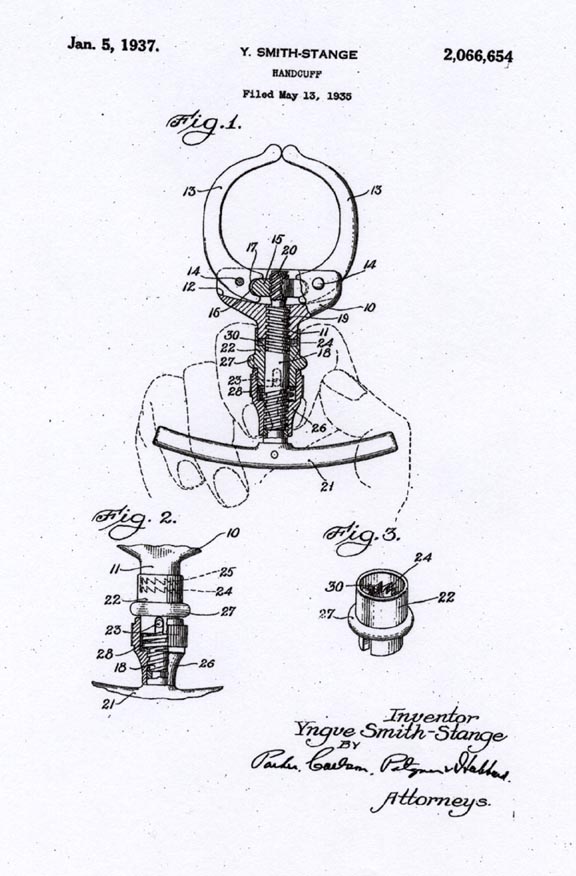
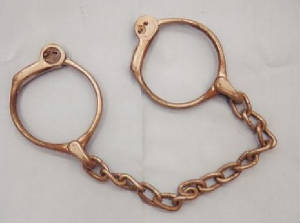
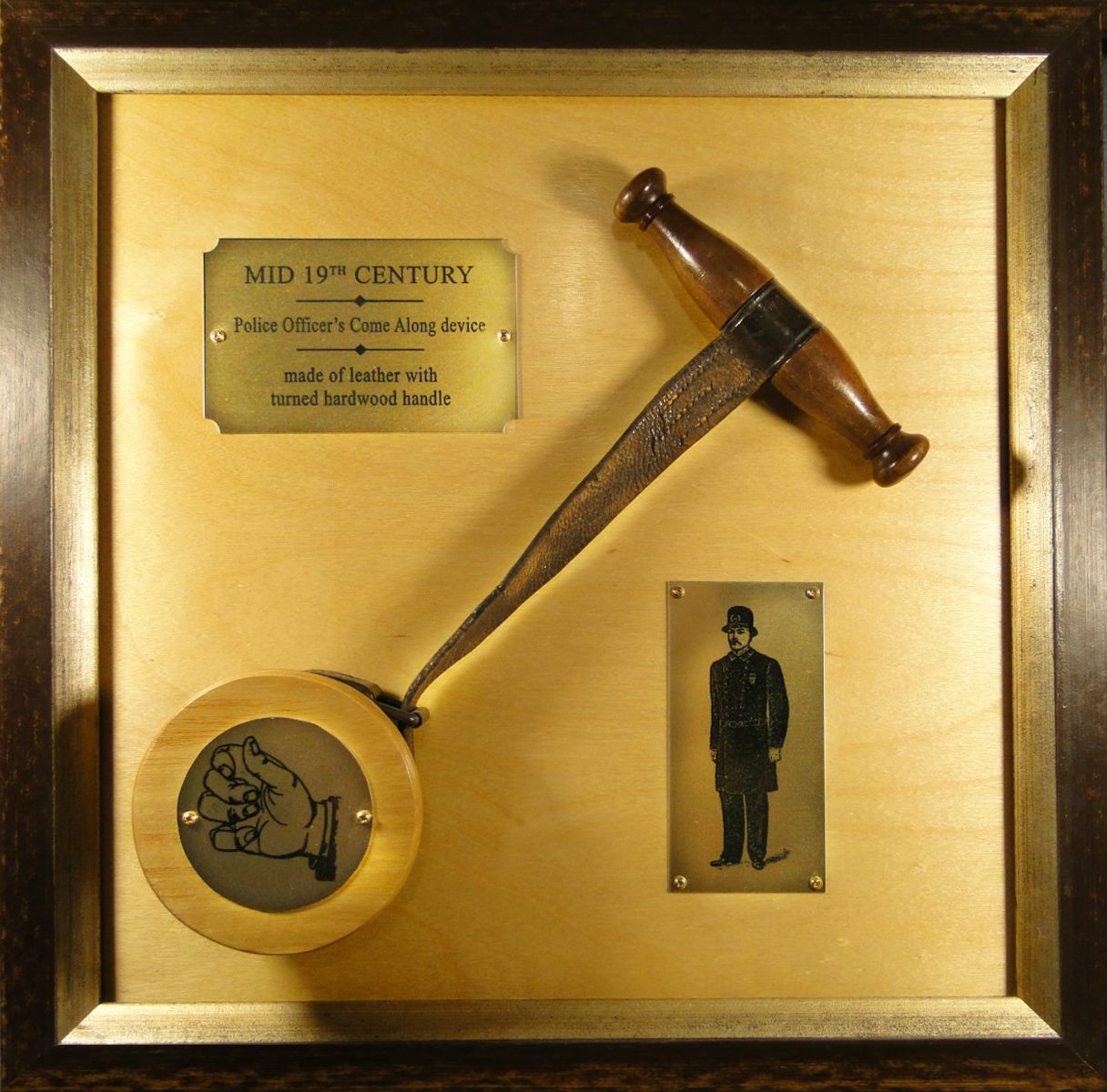 Leather Nipper/Come Along
Leather Nipper/Come Along
POLICE INFORMATION
If you have copies of: your Baltimore Police Department class photo; pictures of our officers, vehicles, and equipment; newspaper articles relating to our department and/or officers; old departmental newsletters; lookouts; wanted posters; or brochures. Information on deceased officers and anything that may help preserve the history and proud traditions of this agency. Please contact retired detective Kenny Driscoll.
This email address is being protected from spambots. You need JavaScript enabled to view it.

NOTICE
How to Dispose of Old Police Items
Please contact Det. Ret. Kenny Driscoll if you have any pictures of you or your family members and wish them remembered here on this tribute site to honor the fine men and women who have served with honor and distinction at the Baltimore Police Department. Anyone with information, photographs, memorabilia, or other "Baltimore City Police" items can contact Ret. Det. Kenny Driscoll at This email address is being protected from spambots. You need JavaScript enabled to view it. follow us on Twitter @BaltoPoliceHist or like us on Facebook or mail pics to 8138 Dundalk Ave., Baltimore, Md. 21222
Copyright © 2002 Baltimore City Police History - Ret Det Kenny Driscoll















 Leg cuffs in use
Leg cuffs in use






















